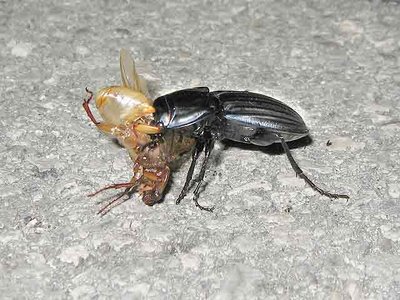
I was out late last night driving a friend all over creation. After I dropped him off and began the return home I noticed something in the head lights that made me stop and investigate. There were hundreds of May Beetles reproducing in the median of the dark secluded road I was traveling.
Species: Phyllophaga spp. [Coleoptera: Scarabaeidae]
Distribution:
Over 100 species of Phyllophaga occur in North America.
Hosts:
The adults feed on the foliage of various trees and shrubs. Each species seems to prefer a different set of trees. The larvae are white grubs that can damage turf.
Damage:
The adults emerge from hiding places in the soil or turf at dusk. These adults fly to trees where they mate and feed by making small irregular holes in the leaves. If this feeding occurs when the tree leaves are still expanding the small holes may increase in size and cause the leaves to have a general tattered look. This is most common on oaks and maples.
Description and Life Cycle:
Different May/June beetle species take from one to three years to complete their life cycle. The C-shaped white grubs feed on a variety of roots and organic matter. They occasionally damage turf but are rarely a problem in ornamental beds. The adults range from 1/2- to one-inch in length and they may be light tan to reddish-brown to black in color. Some are covered with fine hair but most are only lightly covered with hairs. They are usually noticed when attracted to lights at night. Generally, mature adults overwinter and these emerge in May and June to mate and feed on plant foliage. By morning, the adults return to the soil to begin laying eggs. Some species apparently feed and lay eggs over several weeks while other species may only feed for a night or two. The eggs take about two weeks to hatch and the small C-shaped white grubs begin feeding on organic matter and plant roots located in the soil. These grubs mature slowly and most species molt into the second instar during the first year. This partially mature larva digs deep into the soil in the fall and winter to escape freezing temperatures. In the next spring and summer, the grubs return to feed and molt one more time. These third instar grubs may mature by August to October and these dig deep into the soil to pupate. Some species feed as grubs for several summers before pupating and a few species complete development in a single season. The adult beetles are formed by late fall but these remain dormant until the next spring.

I ran around taking pictures and captured the image of this predatory beetle having a feast.

The ancient peoples were able to easily identify the time of year by so many of God’s creatures! The rhythms of creation are even more instructive about time and place than modern calendars. We are only vaguely aware of the world around us and would be well served to tune into the real world and its signs and wonders.

Dear Mr. Billy, J is for June bug. They are really resteling in that first picture and the black beetle is eating a june bug that is about to shed its skin. Ya play with me too much and love you Mr. Billy, Angel
ReplyDeleteDear Angel, "J" is June bug! This is June bug wrestle season and they wouldn’t miss it for the world! The June bug that is being eaten no longer needs his skin. I probably do play with you too much but you’re just so darn irresistible. You know, I love you to Angel; even better Jesus loves you.
ReplyDelete